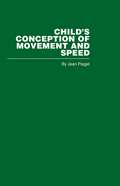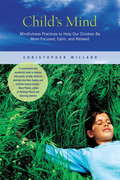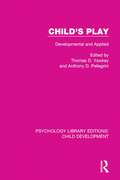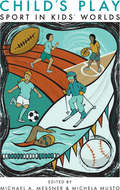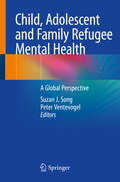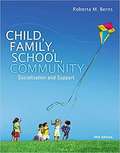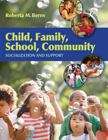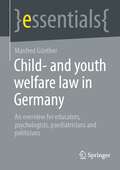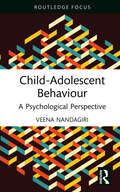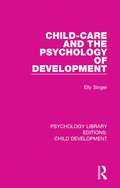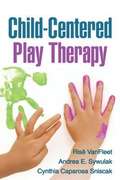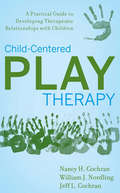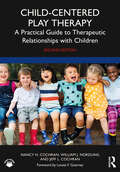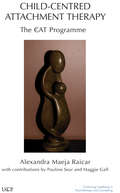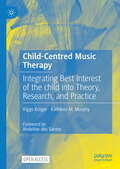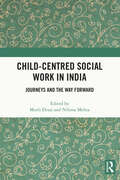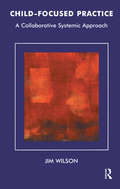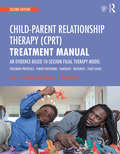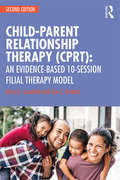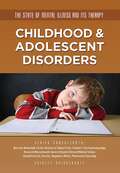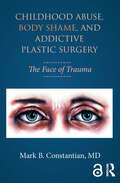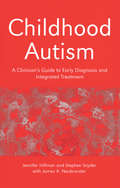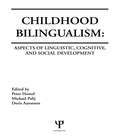- Table View
- List View
Child's Mind
by Christopher WillardThe interest in teaching meditation to children is growing rapidly, as a number of recent stories in the mainstream media have documented. Child's Mind aims to teach parents and child professionals how to integrate mindfulness into their work with children and teach both young children and adolescents the basics of mindfulness and meditation. The book is a great resource for anyone who work with young people, including family coordinators at retreat centers, religious instructors in a range of traditions, teachers, therapists, and medical professionals. Child's Mind aims to teach children the power that comes with the comfort of just being, as well as the capacity to be, be aware, and be comfortable with oneself.
Child's Play: Developmental and Applied (Psychology Library Editions: Child Development #20)
by Anthony D. Pellegrini Thomas D. YawkeyOriginally published in 1984, a major purpose of this book was to bring together in a single volume, work that reflects the wide range of interests that social and behavioural scientists have in play, development and the environment. The intent of the book was to refine and extend concepts and methodologies within and beyond one’s usual area of study. The idea was that this formula and direction would yield novel information and fresh insights. The volume encompasses a wealth of topics concerning structural, functional, and pragmatic aspects of play during early childhood and childhood, and includes strong emphasis on methodological as well as substantive concerns. It was hoped that the chapters here would inspire a new generation of research extending knowledge both in theoretical and applied areas.
Child's Play: Sport in Kids' Worlds
by William A. Corsaro Michael Kehler Torrie Hazelwood Toben F Nelson Michela Musto Professor Jeffrey Montez de Oca Phil Veliz Nicole M. Lavoi Lauren Rauscher A. James Mckeever Chelsey Thul Jeffrey Scholes Brandon Meyer Professor Douglas Hartmann Don Sabo Ann Travers Murray J. Drummond Alex Manning Fatimah Hussein Cheryl Cooky Professor Michael A. MessnerIs sport good for kids? When answering this question, both critics and advocates of youth sports tend to fixate on matters of health, whether condemning contact sports for their concussion risk or prescribing athletics as a cure for the childhood obesity epidemic. Child's Play presents a more nuanced examination of the issue, considering not only the physical impacts of youth athletics, but its psychological and social ramifications as well. The eleven original scholarly essays in this collection provide a probing look into how sports--in community athletic leagues, in schools, and even on television--play a major role in how young people view themselves, shape their identities, and imagine their place in society. Rather than focusing exclusively on self-proclaimed jocks, the book considers how the culture of sports affects a wide variety of children and young people, including those who opt out of athletics. Not only does Child's Play examine disparities across lines of race, class, and gender, it also offers detailed examinations of how various minority populations, from transgender youth to Muslim immigrant girls, have participated in youth sports. Taken together, these essays offer a wide range of approaches to understanding the sociology of youth sports, including data-driven analyses that examine national trends, as well as ethnographic research that gives a voice to individual kids. Child's Play thus presents a comprehensive and compelling analysis of how, for better and for worse, the culture of sports is integral to the development of young people--and with them, the future of our society.
Child, Adolescent and Family Development
by Phillip T. Slee Marilyn Campbell Barbara Spears Phillip T. Slee Marilyn CampbellChild, Adolescent and Family Development is a comprehensive study of human development in the context of the family. Incorporating the latest Australian, British and American research it is an introduction to contemporary theory and issues in the study of child and adolescent development. Heavily illustrated and with a clear design, this sensitively written text is highly readable for students in several disciplines. Modelled on a highly successful first edition published in 1993, the text has been totally reconceptualised. A more thematic linking of materials in the text will allow both students and teachers to follow development either chronologically or thematically. Also, a life cycle approach to topics as they arise will be a very useful addition for many students. The text has an array of useful features, including definitions in the margins, a glossary, discussion questions and activities. Free online support is available, including multiple choice questions, a child observation manual, an easy student guide to research design and techniques, and worksheets. Please note the book no longer comes with a CD; all the CD content is now available via the Website.
Child, Adolescent and Family Refugee Mental Health: A Global Perspective
by Suzan J. Song Peter VentevogelMore than half of the 25.9 million refugees in the world are under the age of 18 and the mental health of these children and adolescents constitutes a growing global public health priority. Refugee children and their families are at increased risk to develop mental health problems, but they often face major challenges in accessing adequate treatment and mental health professionals frequently feel ill-equipped to assist this group. Refugees are faced with a plethora of issues including the ambiguous loss of loved ones, psychological trauma related to past experiences of violence and atrocities, the complexities of daily life as a refugee, and the challenges to adapt to new systems of care and support. Refugees’ life circumstances all too often undermine their agency, asthey face discrimination, stigma, and social isolation or exclusion. Refugees are frequently disconnected from the usual family and community supports that they once had, which creates additional mental distress. As parents struggle with these changes, their children often find it even more difficult to adapt and connect with them. This all leads to increased prevalence of mental health conditions among refugees. Humanitarian policies recommend family-centered interventions that are multi-sectoral,multi-disciplinary, and focus on optimizing resource utilization. Over the last decade, a considerable body of research has emerged around socio-ecological models of mental health, family and community approaches, and resilience and strengths-based theories, but these insights are insufficiently incorporated in the practice of mental health care for refugee children. Clinicians often struggle to grasp the common unique stressors that families face and are not familiar with working with families as units for intervention. Using culturally and contextually informed assessment methods and family-oriented management approaches not only help individual children or adolescents, but also their families. This book aims to provide an overview of the latest theoretical insights from research on sociocultural aspects of mental health and connect these with clinical insights from practical mental health care provision. Using strengths-based, resiliency-oriented and family-centered approaches can enrich clinical practice in refugee mental health, but clinicians need to translate the emerging evidence into concrete steps and interventions. This requires additional skills for the assessment and management of mental health conditions in refugee children and families.The chapters in this book are written by a diverse group of authors using global, multi-disciplinary approaches. The chapters provide examples from various contexts including refugees who are displaced to neighboring countries, refugees ‘on the move’, and refugees and asylum seekers in resettlement settings. This book is therefore a unique resource for clinicians, researchers and policy makers working on mental health issues of refugee children and adolescents around the world.
Child, Family, School, Community: Socialization And Support
by Roberta M. BernsThe best-selling CHILD, FAMILY, SCHOOL, COMMUNITY: SOCIALIZATION AND SUPPORT, now in its Tenth Edition, offers an excellent introduction to socialization that is grounded in a powerful conceptual framework-Urie Bronfenbrenner's Bioecological Model of Human Development. Examining how the school, family, and community influence children's socialization, this book addresses complex issues in a clear, comprehensive fashion. An enjoyable read, it's packed with meaningful, timely examples and learning aids that ensure you gain a solid understanding of chapter concepts. A sensitive presentation of diversity issues includes matters related to culture, ethnicity, gender, sexual orientation, socioeconomic status and special needs. Updated throughout, this edition features a strong emphasis on NAEYC and NASW standards as well as a new neuroscience feature called �Brain Briefs.�
Child, Family, School, Community: Socialization and Support (Eighth Edition)
by Roberta M. BernsBerns' CHILD, FAMILY, SCHOOL, COMMUNITY (CFSC) is intended for child, family, school, and community relations courses offered in both community and 4-year colleges. CFSC examines how the school, family, and community influence children's socialization. Roberta Berns uses Bronfenbrenner's Bioecological Model of Human Development as a framework. Courses for which CFSC is appropriate are often titled: Socialization of the Child; Child and Society, or Child in Society; Child, Family, and Community; or Child Development in the Family and Community. The course is frequently taken by future teachers, education paraprofessionals (e. g. , child care workers), and psychology, sociology or human ecology majors. The course can be found in various departments, including Human/Child Development, Early Childhood Education; Child/Family Relations; Sociology; Psychology or Psychology/Social Behavior; Home Economics; Human or Social Ecology, and Teacher Education. The course is a requirement for California Early Childhood Education certification and is offered at most California community colleges.
Child- and youth welfare law in Germany: An overview for educators, psychologists, paediatricians and politicians (essentials)
by Manfred GüntherTaking into account the KJSG of June 2021, the author presents child and youth law with SGB VIII at its centre in a clear and compact manner. Analyses and commentary appear consistently up-to-date and comprehensible, as he largely dispenses with legalese. Readers - custodial parents, other guardians, young people concerned, social educators in institutions, students - and last but not least the committed "lobbyists" in the youth welfare committees - are thus provided with a quick, profound overview of the essential policy and practice-relevant positions; the focus is on legal entitlements: offers, services as well as important and useful general regulations of the German Social Code for Child and Youth Welfare.
Child-Adolescent Behaviour: A Psychological Perspective
by Veena NandagiriThis book briefly outlines psychological perspectives of the values, attitudes and behaviour of parents in influencing a child’s personality. The volume discusses important factors and family surroundings that influence a growing child’s development and various techniques that parents and teachers may use to inculcate children’s growth and well-being. Various discipline techniques that parents can use with the child and ways in which they can enhance their child’s creativity and achievement levels are explained. It also discusses the causes, signs and types of learning disabilities, such as dyslexia, dysgraphia, dyscalculia and developmental coordination disorder (dyspraxia), and behaviour disorders like anxiety disorders, conduct disorders, oppositional defiant disorder, attention-deficit hyperactivity disorder (ADHD), aggressive behaviour in children and the speech disorder stuttering. The volume gives an elaborate understanding of the diverse changes, conflicts, emotional turmoil and identity crises that adolescent children go through and how parents and teachers can help them to handle this transitional stage.This book will be of interest to psychologists, parents, students and teachers of psychology and scholars of child development, as well as professionals involved in working with children and adolescents, such as teachers, counsellors, doctors, nurses and social workers.
Child-Care and the Psychology of Development (Psychology Library Editions: Child Development #12)
by Elly SingerAre child-care centres good for children? How can we provide good day-care? Feminists have long argued for the provision of day-care facilities so that mothers may be free to work outside the home. The call had enjoyed little support from politicians and experts, however. Feminists had been seen to stand for women’s interests, and psychologists and pedagogues for children’s – as if the two were opposed. Only in the early 1990s had the opinions of politicians and experts begun to change. Yet, even so, a positive policy on day-care was still lacking. Originally published in 1992, Elly Singer’s exciting book shed a fresh and critical light on its subject. She exposes the preoccupations and contradictions of mainstream developmental psychology and its experts, shows how their theories blind them to many important questions, and reveals the almost total denial by mainstream psychology of the daily realities of parents and their children at the time. Elly Singer then proposes fresh ways of thinking to meet the new and different circumstances in which children and parents find themselves in contemporary society.
Child-Centered Play Therapy
by Andrea Sywulak Risë VanfleetHighly practical, instructive, and authoritative, this book vividly describes how to conduct child-centered play therapy. The authors are master clinicians who explain core therapeutic principles and techniques, using rich case material to illustrate treatment of a wide range of difficulties. The focus is on nondirective interventions that allow children to freely express their feelings and take the lead in solving their own problems. Flexible yet systematic guidelines are provided for setting up a playroom; structuring sessions; understanding and responding empathically to children's play themes, including how to handle challenging behaviors; and collaborating effectively with parents.
Child-Centered Play Therapy
by William J. Cochran Nancy H. Nordling Jeff L."The authors . . . make child-centered play therapy readily understandable to those who wish to take advantage of its long history of helping children overcome problems and grow emotionally to a level of maturity difficult to achieve by any other approach. " -From the Foreword, by Louise F. Guerney, PhD, RPT-S A comprehensive resource that thoroughly teaches the theory, methods, and practice of child-centered play therapy Child-Centered Play Therapy: A Practical Guide to Developing Therapeutic Relationships with Children offers how-to direction and practical advice for conducting child-centered play therapy. Filled with case studies, learning activities, and classroom exercises, this book presents extensive coverage of play therapy applications such as setting goals and treatment planning, as well as recommendations for family and systemic services that can be provided along with play therapy. This rich resource provides: A thorough introduction to the theory and guiding principles underlying child-centered play therapy Skill guidance including structuring sessions, tracking, empathy, responding to children's questions, and role-play Effective ways of determining what limits to set in the playroom and how to set them in a therapeutically effective manner Clear methods for monitoring children's progress through stages as well as external measures of progress Practical guidance in adjunct therapist tasks such as playroom set-up, documentation, ending therapy, and working with parents, teachers, and principals Endorsed by Louise Guerney-a founding child-centered play therapy figure who developed the skills-based methods covered in this book-Child-Centered Play Therapy comprehensively and realistically introduces practitioners to the child-centered approach to play therapy and addresses how to incorporate the approach into schools, agencies, or private practice.
Child-Centered Play Therapy Research
by Ray Baggerly Jennifer N. Dee C. Bratton Sue C.The first book of its kind to provide exhaustive, in-depth coverage of play therapy research Child-Centered Play Therapy Research: The Evidence Base for Effective Practice offers mental health professionals, school district administrators, community agency administrators, judges, lawyers, child protection caseworkers, and medical professionals a comprehensive discussion of play therapy research studies. Guidance is provided on evidence-based methods, as well as on how¿future play therapy research should be conducted. Edited by renowned experts in the field of play therapy, this rich compilation features contributions by child-centered play therapy researchers, with relevant discussion of: The history of play therapy research A synopsis of current empirical support Play therapy research on chronically ill children, child witnesses of domestic violence, and victims of natural disasters, among many other topics With coverage of important practice guidelines, Child-Centered Play Therapy Research identifies the most prominent and current play therapy research studies, as well as research directions for clinicians to design evidence-based research studies of their own.
Child-Centered Play Therapy: A Practical Guide to Therapeutic Relationships with Children
by Jeff L. Cochran Nancy H. Cochran William J. NordlingDesigned for professionals adding play therapy to their practices as well as for graduate students, the second edition of Child-Centered Play Therapy is comprehensive, engaging, and practical. The authors provide a strong theoretical base from which to understand the whys and hows of child-centered play therapy and guide readers through all necessary skills for successful practice. From playroom setup, tracking and empathy, limit-setting, and role-play to treatment planning, recognizing stages, measuring progress, and working with parents and teachers, each chapter anticipates readers’ questions and covers key concepts in diverse ways to meet different learning styles. On the book’s website, readers will find a test bank, sample slides and syllabi, treatment planning forms, as well as additional activities and worksheets for students and trainees. Key Features: Everything needed for best practices in child-centered play therapy in one book. Plain-spoken, practical writing. Vivid case stories and vignettes. New neuroscience findings linked to long-held wisdoms of child-centered play therapists. Outcome research reviewed across problem areas of externalizing and internalizing behaviors, school problems, applications with children with disabilities, adverse childhood experiences, and trauma. Endorsed by Louise Guerney, a founding child-centered play therapy figure who developed the skills-based methods covered in this book, Child-Centered Play Therapy comprehensively and realistically introduces practitioners to the child-centered approach to play therapy and addresses how to incorporate the approach into schools, agencies, or private practice.
Child-Centred Attachment Therapy: The CcAT Programme (United Kingdom Council For Psychotherapy Ser.)
by Maggie Gall Alexandra Maeja Raicar Pauline SearThis book describes the development of the Child-Centred Attachment Therapy (CcAT) model of working with children with attachment difficulties. The authors describe, in a vivid and accessible manner, the complexities involved in supporting parents in their struggles to respond positively to the needs of children who have been traumatised by their early experiences. After many years of working with a number of families with children who act out their hurt through difficult behaviours, the authors offer their insights to help both parents and professionals to understand and deal more effectively with such behaviours. The CcAT therapists give an impressive account of their belief in a therapeutic approach that focuses on attachment and protection as prerequisites for promoting healthy relationships.
Child-Centred Music Therapy: Integrating Best Interest of the child into Theory, Research, and Practice
by Kathleen M. Murphy Viggo KrügerThis open access book draws on recent developments in children&’s rights, particularly concerning the child&’s right to participation, provision and protection. Since 1989, the UNCRC has become a catalogue of rights that expresses legal norms used by all countries in the world. The UNCRC can be considered a toolkit that expresses a normative order, that is, a human rights standard for how to legitimately protect children, and to facilitate processes of participation. For many children and adolescents&’ music is a significant source for gaining health and social/cultural participation. Music then, has the potential for realizing values inherent in the UNCRC. The main aim of this book is to utilize The United Nations Conventions on the Rights (UNCRC) as a tool to give an overview of relevant themes, and to critically explore what implications the convention has for the profession of music therapy, and more specifically, music therapy for children and adolescents.
Child-Centred Social Work in India: Journeys and the Way Forward
by Murli Desai Nilima MehtaThis book presents unique semi-autobiographical narratives by leading social work educators and practitioners in India who have done innovative work in the field of child-centred social work (CSW). The practitioners narrate their career journeys and contributions to research, policy, and practice in this field, discuss innovations, achievements, and impact of the work done, and share reflections on the challenges faced, lessons learnt, and the way forward. The volume provides valuable insights into the indigenisation of CSW education and practice and offers suggestions towards developing effective CSW. The authors draw attention towards the need for expansion of preventive service systems for children in the family, community, and school settings, as well as support to and replication of the innovative sociolegal service projects, in coordination with reforms in the justice system to ensure child rights, and human resource planning for child-centred social workers. They also propose promoting CSW education in institutions of social work education to strengthen linkages between theory, research, policy, and practice, and creating a national association for child-centred social workers to build synergy between social work practitioners and educators. The book will be useful to policy makers, educators, students, and practitioners of social work, child development, and child rights. It will also be useful for CSW training institutions and counsellors in schools and government and voluntary organisations.
Child-Focused Practice: A Collaborative Systemic Approach (The Systemic Thinking and Practice Series)
by Jim WilsonThe author, with over twenty years of experience of working with children, writes refreshingly about the practical aspects of his work. He takes traditional and contemporary theories and explains them in the context of how he works with children.
Child-Parent Relationship Therapy (CPRT) Treatment Manual: An Evidence-Based 10-Session Filial Therapy Model
by Sue C. Bratton Garry L. LandrethThis newly expanded and revised edition of the Child-Parent Relationship Therapy (CPRT) Treatment Manual is the essential companion to the second edition of Child-Parent Relationship Therapy (CPRT). The second edition is updated to include four new CPRT treatment protocols and parent notebooks adapted for specific populations: parents of toddlers, parents of preadolescents, adoptive families, and the teacher/student relationship, along with the revised original CPRT protocol and parent notebook for ages 3−10. This manual provides the CPRT/filial therapist a comprehensive framework for conducting CPRT. Included are detailed outlines, teaching aides, activities, and resources for each of the 10 sessions. The manual is divided into two major sections, Therapist Protocol and Parent Notebook, and contains a comprehensive CPRT Training Resources section along with an index to the accompanying Companion Website. The accompanying Companion Website contains all necessary and supplemental training materials in a format that allows for ease of reproduction and enhanced usability including the following: CPRT Protocol—Ages 3 to 10 and Parent Notebook Toddler Adapted CPRT Protocol and Parent Notebook Preadolescent Adapted CPRT Protocol and Parent Notebook Adoptive Families Adapted CPRT Protocol and Parent Notebook Teacher/Student Adapted Protocol and Teacher Notebook Therapist Study Guide Training Resources, Teaching Aides and Supplemental Materials Marketing Materials Assessments Drawing on their extensive experience as professional play therapists and filial therapists, Bratton and Landreth apply the principles of CCPT and CPRT in this easy-to-follow protocol for practitioners to successfully implement the evidence-based CPRT model. By using this manual and the accompanying Companion Website in conjunction with the CPRT text, filial therapists will have a complete package for training parents in CCPT skills to act as therapeutic agents with their own children.
Child-Parent Relationship Therapy (CPRT): An Evidence-Based 10-Session Filial Therapy Model
by Sue C. Bratton Garry L. LandrethChild-Parent Relationship Therapy (CPRT), grounded in the attitudes and principles of Child-Centered Play Therapy (CCPT), is based on the belief that a parent acting as an agent for change in place of a play therapist has potential for significant and lasting therapeutic gains. This newly expanded and revised edition of Child-Parent Relationship Therapy (CPRT) describes training objectives, essential skills and concepts taught in each session, as well as the format for supervising parents’ play sessions. Transcripts of actual sessions demonstrate process and content in the 10 CPRT training sessions. Research demonstrating the effectiveness of CPRT on child and parent outcomes is presented in support of CPRT’s designation as an evidence-based treatment model. This second edition is updated to include six new chapters exploring the topics of cultural considerations for working with ethnically and racially diverse families, neuroscience support for CPRT, and adaptions for specific populations including parents of toddlers, parents of preadolescents, adoptive families, and the teacher/student relationship. The authors’ expertise and experience results in a book that is essential reading for both students and professionals. By using this text and the accompanying treatment manual, filial therapists will have a complete package for training parents in the CPRT model.
Childhood & Adolescent Disorders (The State of Mental Illness and Its Ther)
by Shirley BrinkerhoffMental disorders can affect people of all ages and backgrounds. But specific mental disorders may be more likely to affect certain groups of people than other groups. For example, some mental disorders, like attention deficit hyperactivity disorder, are more common in children and adolescents than in adults. Dealing with the issues that surround mental disorders can be difficult for anyone. However, young people who must balance a mental disorder with other stresses, like schoolwork, extra-curricular activities, social pressures, and physical changes, may face additional challenges coping with mental disorders. With promising discoveries and developments in psychiatric drug treatments, doctors now have more ways than ever to help patients with childhood and adolescent disorders. In this book, you will read about: *Tracy, who refused to hug or kiss her parents or even look them in the eye. *Kelly, a child with mental retardation who needed schooling but couldn't stay in her classroom because she banged her head against the walls. *Tony, whose undiagnosed and untreated ADHD led him into drug and alcohol abuse. *Carissa, who was sent home from summer camp because of her tics and echolalia. Learn how parents, doctors and psychiatrists were able to help each of these young people cope with their disorders and achieve their individual potential.
Childhood Abuse, Body Shame, and Addictive Plastic Surgery: The Face of Trauma
by Mark B. ConstantianChildhood Abuse, Body Shame, and Addictive Plastic Surgery explores the psychopathology that plastic surgeons can encounter when seemingly excellent surgical candidates develop body dysmorphic disorder postoperatively. By examining how developmental abuse and neglect influence body image, personality, addictions, resilience, and adult health, this highly readable book uncovers the childhood sources of body dysmorphic disorder. Written from the unique perspective of a leading plastic surgeon with extensive experience in this area and featuring many poignant clinical vignettes and groundbreaking trauma research, this heavily referenced text offers a new explanation for body dysmorphic disorder that provides help for therapists and surgeons and hope for patients.
Childhood Autism: A Clinician's Guide to Early Diagnosis and Integrated Treatment
by Stephen Snyder Jennifer Hillman James NeubranderChildhood Autism provides clinicians with a comprehensive guide for working with autistic children and their families. It offers practical assistance with early diagnosis, cutting edge treatment options and goals, interdisciplinary insights, and available resources. Empirical research findings are presented in a clear, accessible manner. Perhaps most importantly, vivid case examples bring both the therapist’s and patient’s experience to the fore as they work towards recovery. This clear and informative book should be required reading for professionals and students in the fields of medicine, social work, psychology, education, and any other clinicians who work with children on the autism spectrum.
Childhood Bilingualism: Aspects of Linguistic, Cognitive, and Social Development
by Doris Aaronson Peter Homel Michael PalijFirst published in 1987. This volume is based primarily on a conference on childhood bilingualism held at New York University on June 25 and 26, 1982 with an interest in exploring the nature of bilingual cognition and the effect of bilingualism on psychological development.
